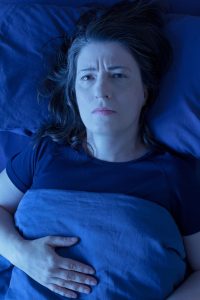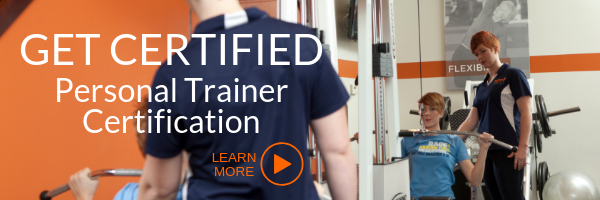The right exercise at the right time can make a difference for clients suffering from RLS.

“Purposeful movement” is typically seen as a healthy endeavor, but erratic restless movement can be less than desirable.
Restless Leg Syndrome, or RLS, is considered to be a sleep disorder, although its discomfort and outright pain make sleep nearly impossible for some sufferers. While there are many symptoms clustered together to encompass RLS, most individuals living with this ailment describe sensations such as burning, electric shock, itching, and “creeping flesh”.
In a somewhat futile attempt at alleviating such symptoms, many patients feel the sudden urge to “walk off” these sensations. Since most incidences are observed upon laying down in preparation for a night’s sleep, quiet slumber can prove highly elusive. While these feelings most commonly occur in the lower extremities, RLS can also affect the arms and hands.
Causes of RLS
While RLS does not necessarily discriminate based upon one’s gender, there is a high incidence of women developing these symptoms as they approach menopause. This phase of a woman’s life is characterized by significant hormonal fluctuations, most notably being the circulating levels of estrogen. Research has demonstrated that very low estrogen can inhibit the metabolism of magnesium. Since this mineral plays a dominant role in encouraging muscle relaxation, a lack thereof can easily trigger restless leg syndrome.
While there are many derivatives of origin for RLS, the single constant seems to be the cluster of irritating sensations that may cast a profoundly negative shadow on activities of daily life. While there are pharmaceutical solutions and treatments to help mitigate such symptoms, more natural paths do exist.
The Role Of Exercise in Alleviating Symptoms
Exercise seems to have elicited mixed results in those who have reported their data to medical professionals. Walking is the most easily accessible form of movement employed to ease the discomfort of RLS. However, timing, as well as the intensity of such exercise, is crucial to its benefits.
Both leisurely strolls and moderate “speed walking” can be effective; even 20-minute increments engaged in once or twice daily prove beneficial. While this activity will fatigue the leg muscles, thereby easing their restlessness at the end of the day, vigorous exercise performed close to one’s bedtime may actually swing the pendulum in the opposite direction, exacerbating symptoms and further interfering with a good night’s sleep.
Controlled Breathing Techniques
Another option that has proven to be effective in combating the negative sensations associated with RLS is participation in a yoga class. The slower, deliberate movements of this Eastern discipline help to calm twitching muscles. The modulated breathing in which one engages during a yoga class creates a serene mind-body-soul connection which can be very soothing for restless legs.
Avoiding Prolonged Inactivity
For those whose lifestyles keep them chained to a desk throughout the workday, such lack of mobility may cause RLS symptoms to increase. For these individuals, discomfort can be alleviated by making time every hour to not only stretch the legs, but also to rotate the ankles 360 degrees several times. Standing while holding on to the edge of the desk, and performing a series of calf raises each hour, will go a long way towards attenuating tensed nerves and releasing stiff calf muscles. These same series of movements may be performed again prior to bedtime.
Whether the exercise engaged in is walking, yoga, swimming or simple calf raises, the resultant lactic acid build-up that typically follows physical activity can be more distressing to individuals living with restless leg syndrome. To prevent lactic acid discomfort, slow but thorough stretching should always be engaged in at the end of any movement session.
Follow a Schedule
Restless leg syndrome often occurs in people whose sleep patterns are irregular, or who already suffer from mental/emotional fatigue. Establishing a regimented bedtime routine and strictly adhering to it over time will help overcome the irritability commonly associated with the negative sensations of RLS. Learn more about sleep science and solutions to help with this mission.
________________________________________
ARTICLE REFERENCES
- https://www.everydayhealth.com/sleep/triggers-that-make-restless-legs-worse.aspx
- https://healthunlocked.com/rlsuk/posts/131145730/does-exercise-make-it-worse-for-you
- https://www.everydayhealth.com/sleep/turn-to-exercise-as-a-treatment-for-restless-legs-syndrome.aspx
- https://www.livestrong.com/article/298025-causes-of-restless-legs-after-exercise/
- https://www.webmd.com/brain/restless-legs-syndrome/features/restless-legs-syndrome-and-lifestyle#1
- https://www.ncbi.nlm.nih.gov/pmc/articles/PMC5003313/
- https://healthguides.healthgrades.com/article/try-these-exercises-for-restless-legs
- https://www.34-menopause-symptoms.com/sleep-disorders/articles/the-benefits-of-walking-for-restless-leg-syndrome.htm
- http://www.onlymyhealth.com/search_benefits-of-exercise-to-treat-rls_Articles.html
- http://www.lifescript.com/health/centers/restless_legs_syndrome/articles/10_ways_to_exercise_with_restless_legs_syndrome.aspx







